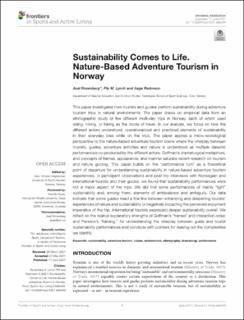| dc.contributor.author | Rosenberg, Axel | |
| dc.contributor.author | Radmann, Aage | |
| dc.contributor.author | Lynch, Philippa Marie | |
| dc.date.accessioned | 2022-03-21T21:34:14Z | |
| dc.date.available | 2022-03-21T21:34:14Z | |
| dc.date.created | 2021-11-01T11:37:10Z | |
| dc.date.issued | 2021 | |
| dc.identifier.citation | Frontiers in Sports and Active Living. 2021, 3, Artikkel 686459. | en_US |
| dc.identifier.issn | 2624-9367 | |
| dc.identifier.uri | https://hdl.handle.net/11250/2986642 | |
| dc.description | This is an open-access article distributed under the terms of the Creative Commons Attribution License (CC BY). The use, distribution or reproduction in other forums is permitted, provided the original author(s) and the copyright owner(s) are credited and that the original publication in this journal is cited, in accordance with accepted academic practice. No use, distribution or reproduction is permitted which does not comply with these terms. | en_US |
| dc.description.abstract | This paper investigates how tourists and guides perform sustainability during adventure tourism trips in natural environments. The paper draws on empirical data from an ethnographic study of five different multi-day trips in Norway, each of which used skiing, hiking, or biking as the mode of travel. In our analysis, we focus on how the different actors understood, operationalized and practiced elements of sustainability in their everyday lives while on the trips. The paper applies a micro-sociological perspective to the nature-based adventure tourism scene where the interplay between tourists, guides, adventure activities and nature is understood as multiple dialectic performances co-produced by the different actors. Goffman's dramaturgical metaphors, and concepts of frames, appearance, and manner saturate recent research on tourism and nature guiding. This paper builds on the “performance turn” as a theoretical point of departure for understanding sustainability in nature-based adventure tourism experiences. In participant observations and post-trip interviews with Norwegian and international tourists and their guides, we found that sustainability performances were not a major aspect of the trips. We did find some performances of mainly “light” sustainability and, among them, elements of ambivalence and ambiguity. Our data indicate that some guides tread a fine line between enhancing and deepening tourists' experiences of nature and sustainability or negatively impacting the perceived enjoyment imperative of the trip. International tourists expressed deeper sustainability overall. We reflect on the relative explanatory strengths of Goffman's “frames” and interaction order, and Persson's “framing,” for understanding the interplay between guide and tourist sustainability performances and conclude with pointers for teasing out the complexities we identify. | en_US |
| dc.language.iso | eng | en_US |
| dc.subject | adventure tourism | en_US |
| dc.subject | dramaturgy | en_US |
| dc.subject | environment | en_US |
| dc.subject | ethnography | en_US |
| dc.subject | nature | en_US |
| dc.subject | performance | en_US |
| dc.subject | sustainability | en_US |
| dc.title | Sustainability comes to life: Nature-based adventure tourism in Norway | en_US |
| dc.type | Peer reviewed | en_US |
| dc.type | Journal article | en_US |
| dc.description.version | publishedVersion | en_US |
| dc.rights.holder | © 2021 Rosenberg, Lynch and Radmann | en_US |
| dc.source.pagenumber | 16 | en_US |
| dc.source.volume | 3 | en_US |
| dc.source.journal | Frontiers in Sports and Active Living | en_US |
| dc.identifier.doi | 10.3389/fspor.2021.686459 | |
| dc.identifier.cristin | 1950146 | |
| dc.description.localcode | Institutt for lærerutdanning og friluftslivsstudier / Department of Teacher Education and Outdoor Studies | en_US |
| dc.source.articlenumber | 686459 | en_US |
| cristin.ispublished | true | |
| cristin.fulltext | original | |
| cristin.qualitycode | 1 | |
